brakes MERCEDES-BENZ SPRINTER 2014 MY14 Operator’s Manual
[x] Cancel search | Manufacturer: MERCEDES-BENZ, Model Year: 2014, Model line: SPRINTER, Model: MERCEDES-BENZ SPRINTER 2014Pages: 338, PDF Size: 6.78 MB
Page 8 of 338
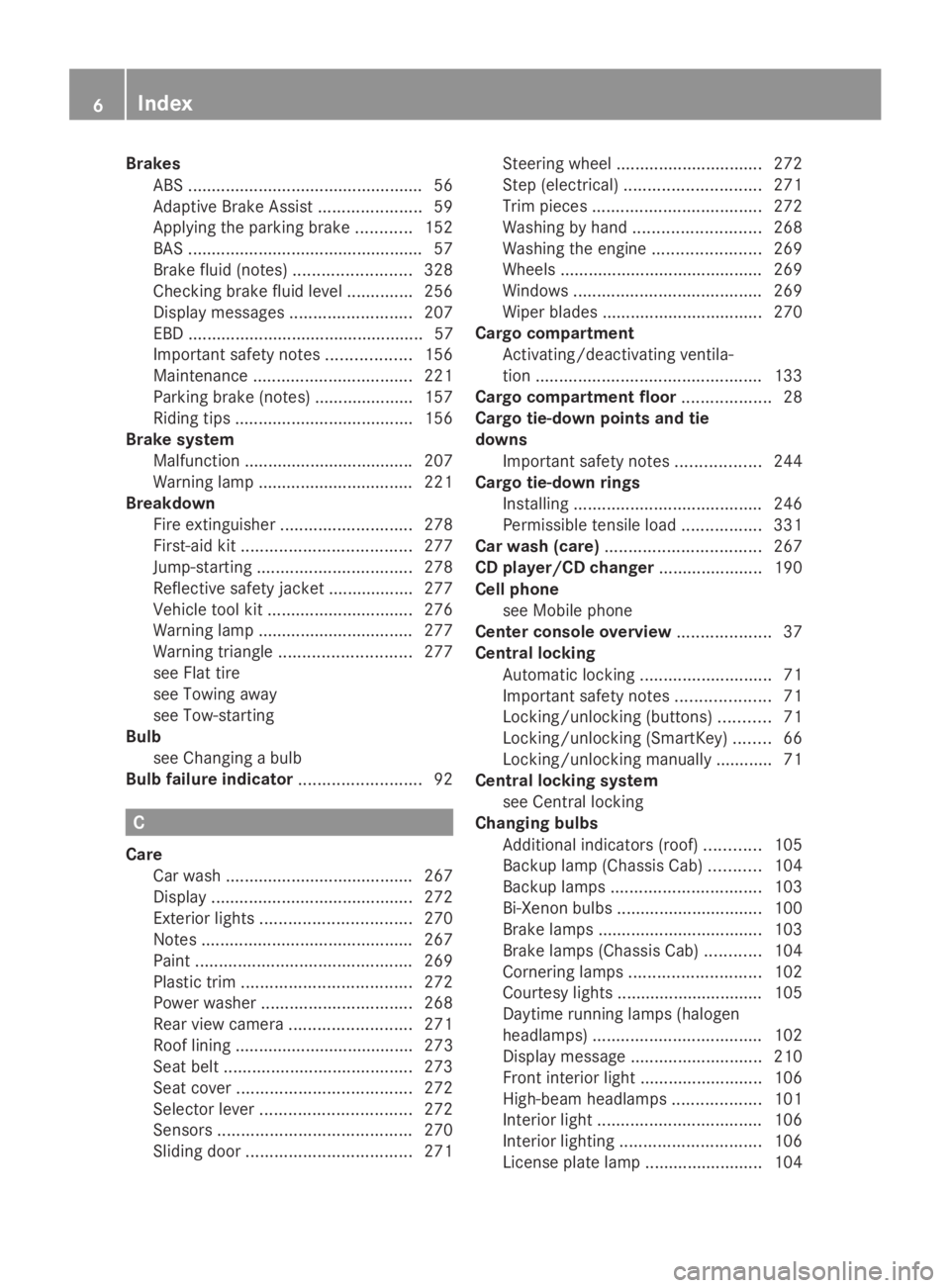
Brakes
ABS .................................................. 56
Adaptive Brake Assist ......................59
Applying the parking brake ............152
BAS .................................................. 57
Brake fluid (notes) .........................328
Checking brake fluid leve l.............. 256
Display messages ..........................207
EBD .................................................. 57
Important safety notes ..................156
Maintenance .................................. 221
Parking brake (notes) ..................... 157
Riding tips ...................................... 156
Brake system
Malfunction ................................... .207
Warning lamp ................................. 221
Breakdown
Fire extinguisher ............................ 278
First-aid kit .................................... 277
Jump-starting ................................. 278
Reflective safety jacket .................. 277
Vehicle tool kit ............................... 276
Warning lamp ................................. 277
Warning triangle ............................ 277
see Flat tire
see Towing away
see Tow-starting
Bulb
see Changing a bulb
Bulb failure indicator ..........................92C
Care Car wash ........................................ 267
Display ........................................... 272
Exterior lights ................................ 270
Notes ............................................. 267
Paint .............................................. 269
Plastic trim .................................... 272
Power washer ................................ 268
Rear view camera .......................... 271
Roof lining ...................................... 273
Seat belt ........................................ 273
Seat cover ..................................... 272
Selector lever ................................ 272
Sensors ......................................... 270
Sliding door ................................... 271Steering wheel
............................... 272
Step (electrical) ............................. 271
Trim pieces .................................... 272
Washing by hand ........................... 268
Washing the engine .......................269
Wheels ........................................... 269
Windows ........................................ 269
Wiper blades .................................. 270
Cargo compartment
Activating/deactivating ventila-
tion ................................................ 133
Cargo compartment floor ...................28
Cargo tie-down points and tie
downs
Important safety notes ..................244
Cargo tie-down rings
Installing ........................................ 246
Permissible tensile loa d................. 331
Car wash (care) ................................. 267
CD player/CD changer ......................190
Cell phone see Mobile phone
Center console overview ....................37
Central locking Automatic locking ............................ 71
Important safety notes ....................71
Locking/unlocking (buttons) ...........71
Locking/unlocking (SmartKey) ........66
Locking/unlocking manually ............ 71
Central locking system
see Central locking
Changing bulbs
Additional indicators (roof) ............105
Backup lamp (Chassis Cab) ...........104
Backup lamps ................................ 103
Bi-Xenon bulbs ............................... 100
Brake lamps ................................... 103
Brake lamps (Chassis Cab) ............104
Cornering lamps ............................ 102
Courtesy lights ............................... 105
Daytime running lamps (halogen
headlamps) .................................... 102
Display message ............................ 210
Front interior light ..........................106
High-beam headlamps ...................101
Interior light ................................... 106
Interior lighting .............................. 106
License plate lamp .........................1046
Index
Page 11 of 338
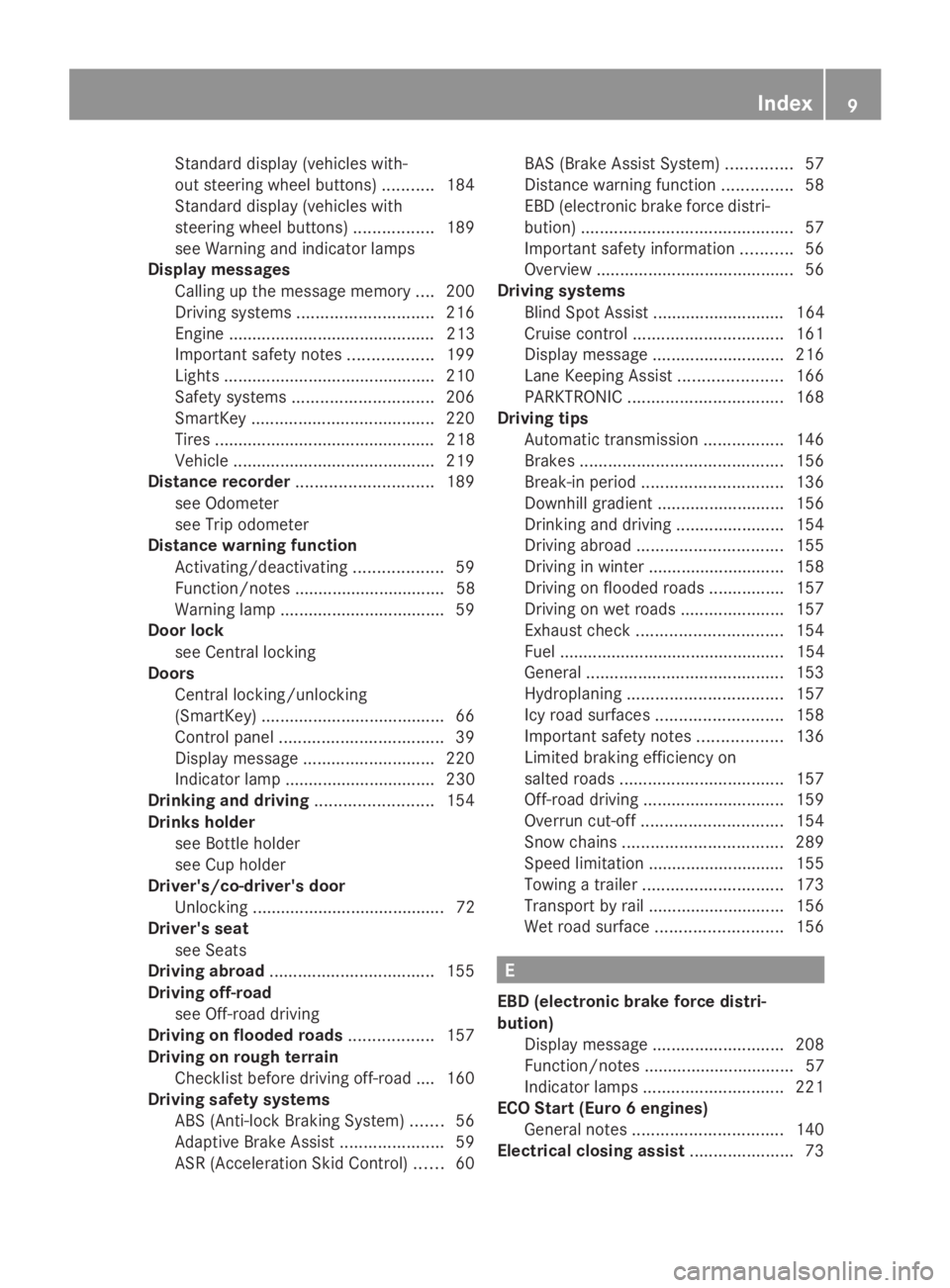
Standard display (vehicles with-
out steering wheel buttons)
...........184
Standard display (vehicles with
steering wheel buttons) .................189
see Warning and indicator lamps
Display messages
Calling up the message memory ....200
Driving systems ............................. 216
Engine ............................................ 213
Important safety notes ..................199
Lights ............................................ .210
Safety systems .............................. 206
SmartKey ....................................... 220
Tires ............................................... 218
Vehicle .......................................... .219
Distance recorder ............................. 189
see Odometer
see Trip odometer
Distance warning function
Activating/deactivating ...................59
Function/notes ................................ 58
Warning lamp ................................... 59
Door lock
see Central locking
Doors
Central locking/unlocking
(SmartKey) ....................................... 66
Control panel ................................... 39
Display message ............................ 220
Indicator lamp ................................ 230
Drinking and driving .........................154
Drinks holder see Bottle holder
see Cup holder
Driver's/co-driver's door
Unlocking ......................................... 72
Driver's seat
see Seats
Driving abroad ................................... 155
Driving off-road see Off-road driving
Driving on flooded roads ..................157
Driving on rough terrain Checklist before driving off-road .... 160
Driving safety systems
ABS (Anti-lock Braking System) .......56
Adaptive Brake Assist ......................59
ASR (Acceleration Skid Control )...... 60 BAS (Brake Assist System)
..............57
Distance warning function ...............58
EBD (electronic brake force distri-
bution) ............................................. 57
Important safety information ...........56
Overview .......................................... 56
Driving systems
Blind Spot Assist ............................ 164
Cruise control ................................ 161
Display message ............................ 216
Lane Keeping Assist ......................166
PARKTRONIC ................................. 168
Driving tips
Automatic transmission .................146
Brakes ........................................... 156
Break-in period .............................. 136
Downhill gradient ........................... 156
Drinking and driving .......................154
Driving abroad ............................... 155
Driving in winter ............................ .158
Driving on flooded roads ................157
Driving on wet roads ......................157
Exhaust check ............................... 154
Fuel ................................................ 154
General .......................................... 153
Hydroplaning ................................. 157
Icy road surfaces ........................... 158
Important safety notes ..................136
Limited braking efficiency on
salted road s................................... 157
Off-road driving .............................. 159
Overrun cut-off .............................. 154
Snow chains .................................. 289
Speed limitation ............................ .155
Towing a trailer .............................. 173
Transport by rail ............................ .156
Wet road surface ........................... 156 E
EBD (electronic brake force distri-
bution) Display message ............................ 208
Function/notes ................................ 57
Indicator lamps .............................. 221
ECO Start (Euro 6 engines)
General notes ................................ 140
Electrical closing assist ......................73 Index
9
Page 23 of 338
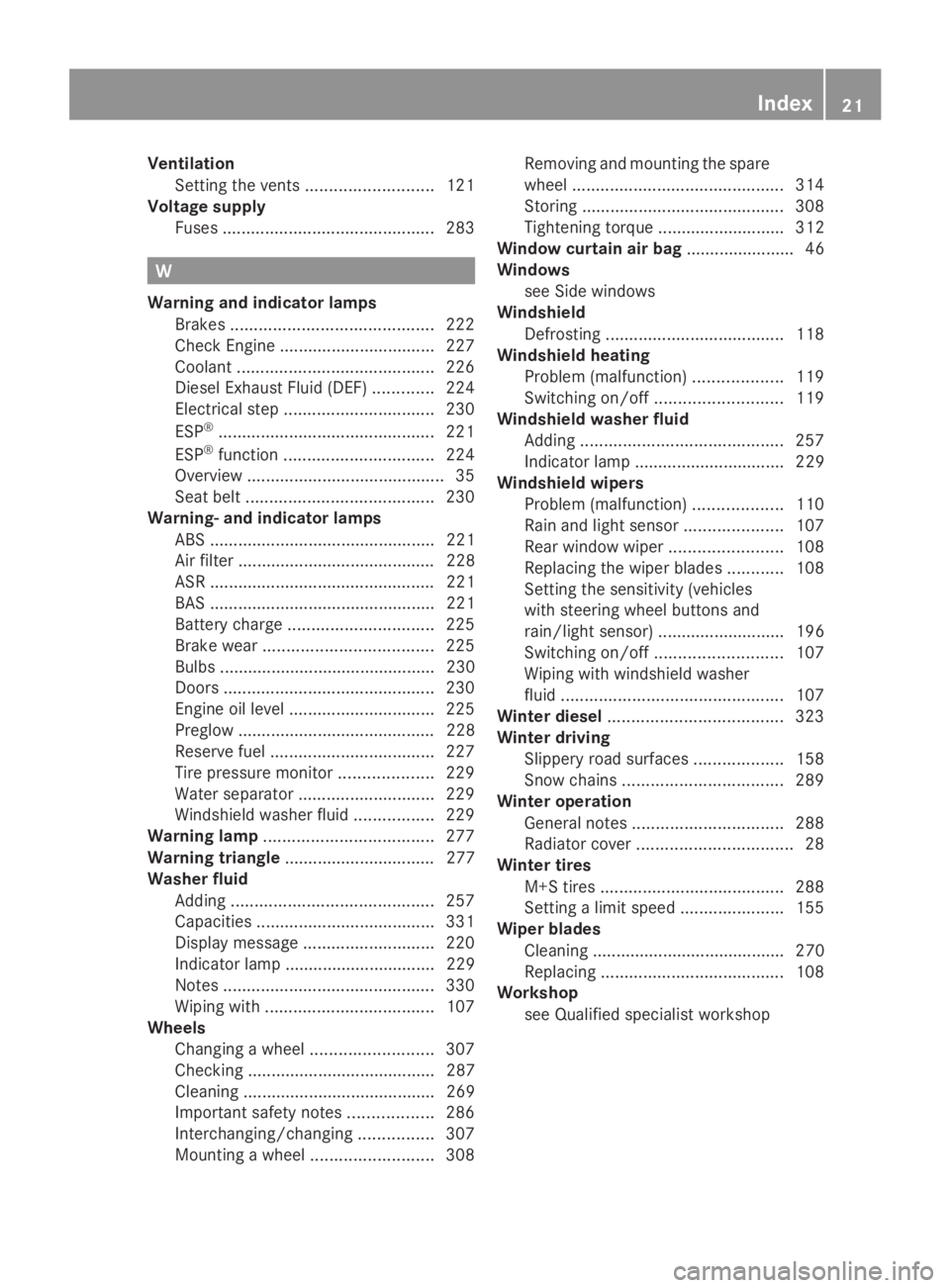
Ventilation
Setting the vents ........................... 121
Voltage supply
Fuses ............................................. 283W
Warning and indicator lamps Brakes ........................................... 222
Check Engine ................................. 227
Coolant .......................................... 226
Diesel Exhaust Fluid (DEF) .............224
Electrical step ................................ 230
ESP ®
.............................................. 221
ESP ®
function ................................ 224
Overview .......................................... 35
Seat belt ........................................ 230
Warning- and indicator lamps
ABS ................................................ 221
Air filter .......................................... 228
ASR ................................................ 221
BAS ................................................ 221
Battery charge ............................... 225
Brake wear .................................... 225
Bulbs .............................................. 230
Doors ............................................. 230
Engine oil level ............................... 225
Preglow .......................................... 228
Reserve fuel ................................... 227
Tire pressure monitor ....................229
Water separator ............................. 229
Windshield washer fluid .................229
Warning lamp .................................... 277
Warning triangle ................................ 277
Washer fluid Adding ........................................... 257
Capacities ...................................... 331
Display message ............................ 220
Indicator lamp ................................ 229
Notes ............................................. 330
Wiping with .................................... 107
Wheels
Changing a wheel .......................... 307
Checking ........................................ 287
Cleaning ......................................... 269
Important safety notes ..................286
Interchanging/changing ................307
Mounting a wheel .......................... 308Removing and mounting the spare
wheel
............................................. 314
Storing ........................................... 308
Tightening torque ........................... 312
Window curtain air bag ....................... 46
Windows see Side windows
Windshield
Defrosting ...................................... 118
Windshield heating
Problem (malfunction) ...................119
Switching on/off ........................... 119
Windshield washer fluid
Adding ........................................... 257
Indicator lamp ................................ 229
Windshield wipers
Problem (malfunction) ...................110
Rain and light sensor .....................107
Rear window wiper ........................108
Replacing the wiper blades ............108
Setting the sensitivity (vehicles
with steering wheel buttons and
rain/light sensor) ........................... 196
Switching on/off ........................... 107
Wiping with windshield washer
fluid ............................................... 107
Winter diesel ..................................... 323
Winter driving Slippery road surfaces ...................158
Snow chains .................................. 289
Winter operation
General notes ................................ 288
Radiator cover ................................. 28
Winter tires
M+S tires ....................................... 288
Setting a limit speed ......................155
Wiper blades
Cleaning ......................................... 270
Replacing ....................................... 108
Workshop
see Qualified specialist workshop Index
21
Page 31 of 338
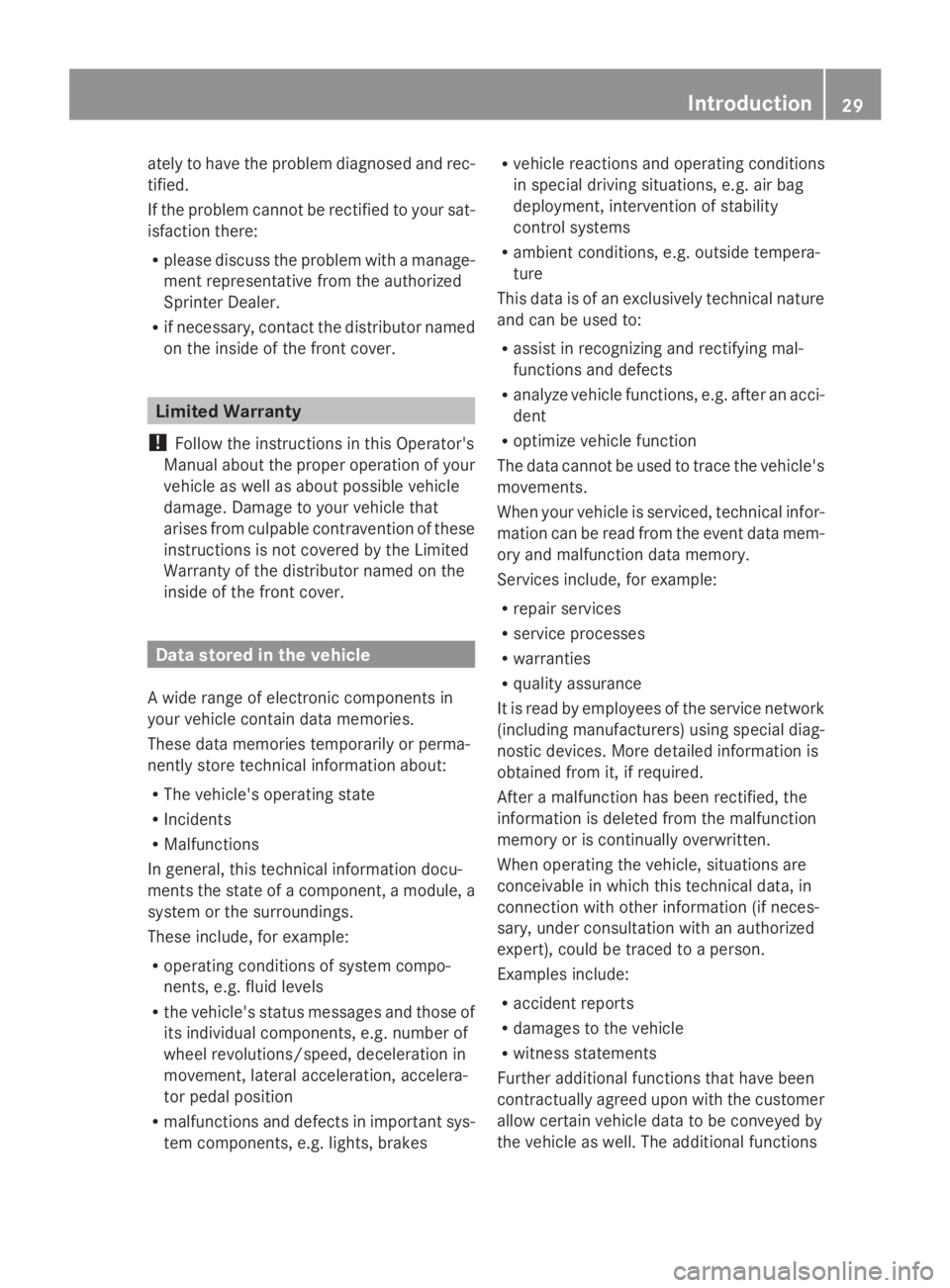
ately to have the problem diagnosed and rec-
tified.
If the problem cannot be rectified to your sat-
isfaction there:
R please discuss the problem with a manage-
ment representative from the authorized
Sprinter Dealer.
R if necessary, contact the distributor named
on the inside of the front cover. Limited Warranty
! Follow the instructions in this Operator's
Manual about the proper operation of your
vehicle as well as about possible vehicle
damage. Damage to your vehicle that
arises from culpable contravention of these
instructions is not covered by the Limited
Warranty of the distributor named on the
inside of the front cover. Data stored in the vehicle
A wide range of electronic components in
your vehicle contain data memories.
These data memories temporarily or perma-
nently store technical information about:
R The vehicle's operating state
R Incidents
R Malfunctions
In general, this technical information docu-
ments the state of a component, a module, a
system or the surroundings.
These include, for example:
R operating conditions of system compo-
nents, e.g. fluid levels
R the vehicle's status messages and those of
its individual components, e.g. number of
wheel revolutions/speed, deceleration in
movement, lateral acceleration, accelera-
tor pedal position
R malfunctions and defects in important sys-
tem components, e.g. lights, brakes R
vehicle reactions and operating conditions
in special driving situations, e.g. air bag
deployment, intervention of stability
control systems
R ambient conditions, e.g. outside tempera-
ture
This data is of an exclusively technical nature
and can be used to:
R assist in recognizing and rectifying mal-
functions and defects
R analyze vehicle functions, e.g. after an acci-
dent
R optimize vehicle function
The data cannot be used to trace the vehicle's
movements.
When your vehicle is serviced, technical infor-
mation can be read from the event data mem-
ory and malfunction data memory.
Services include, for example:
R repair services
R service processes
R warranties
R quality assurance
It is read by employees of the service network
(including manufacturers) using special diag-
nostic devices. More detailed information is
obtained from it, if required.
After a malfunction has been rectified, the
information is deleted from the malfunction
memory or is continually overwritten.
When operating the vehicle, situations are
conceivable in which this technical data, in
connection with other information (if neces-
sary, under consultation with an authorized
expert), could be traced to a person.
Examples include:
R accident reports
R damages to the vehicle
R witness statements
Further additional functions that have been
contractually agreed upon with the customer
allow certain vehicle data to be conveyed by
the vehicle as well. The additional functions Introduction
29 Z
Page 59 of 338
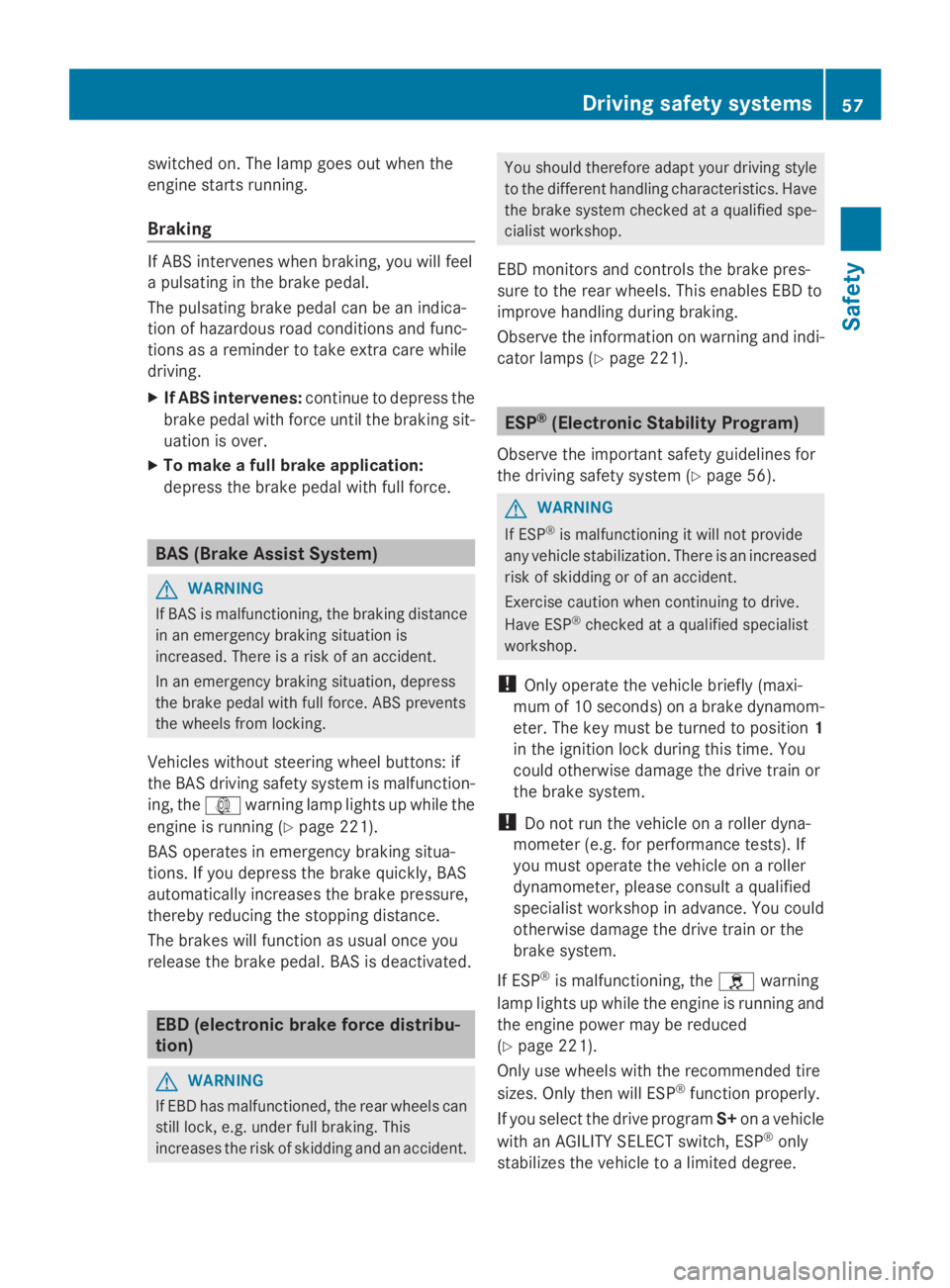
switched on. The lamp goes out when the
engine starts running.
Braking If ABS intervenes when braking, you will feel
a pulsating in the brake pedal.
The pulsating brake pedal can be an indica-
tion of hazardous road conditions and func-
tions as a reminder to take extra care while
driving.
X If ABS intervenes: continue to depress the
brake pedal with force until the braking sit-
uation is over.
X To make a full brake application:
depress the brake pedal with full force. BAS (Brake Assist System)
G
WARNING
If BAS is malfunctioning, the braking distance
in an emergency braking situation is
increased. There is a risk of an accident.
In an emergency braking situation, depress
the brake pedal with full force. ABS prevents
the wheels from locking.
Vehicles without steering wheel buttons: if
the BAS driving safety system is malfunction-
ing, the 003Dwarning lamp lights up while the
engine is running (Y page 221).
BAS operates in emergency braking situa-
tions. If you depress the brake quickly, BAS
automatically increases the brake pressure,
thereby reducing the stopping distance.
The brakes will function as usual once you
release the brake pedal. BAS is deactivated. EBD (electronic brake force distribu-
tion)
G
WARNING
If EBD has malfunctioned, the rear wheels can
still lock, e.g. under full braking. This
increases the risk of skidding and an accident. You should therefore adapt your driving style
to the different handling characteristics. Have
the brake system checked at a qualified spe-
cialist workshop.
EBD monitors and controls the brake pres-
sure to the rear wheels. This enables EBD to
improve handling during braking.
Observe the information on warning and indi-
cator lamps (Y page 221). ESP
®
(Electronic Stability Program)
Observe the important safety guidelines for
the driving safety system (Y page 56). G
WARNING
If ESP ®
is malfunctioning it will not provide
any vehicle stabilization. There is an increased
risk of skidding or of an accident.
Exercise caution when continuing to drive.
Have ESP ®
checked at a qualified specialist
workshop.
! Only operate the vehicle briefly (maxi-
mum of 10 seconds) on a brake dynamom-
eter. The key must be turned to position 1
in the ignition lock during this time. You
could otherwise damage the drive train or
the brake system.
! Do not run the vehicle on a roller dyna-
mometer (e.g. for performance tests). If
you must operate the vehicle on a roller
dynamometer, please consult a qualified
specialist workshop in advance. You could
otherwise damage the drive train or the
brake system.
If ESP ®
is malfunctioning, the 0089warning
lamp lights up while the engine is running and
the engine power may be reduced
(Y page 221).
Only use wheels with the recommended tire
sizes. Only then will ESP ®
function properly.
If you select the drive program S+on a vehicle
with an AGILITY SELECT switch, ESP ®
only
stabilizes the vehicle to a limited degree. Driving safety systems
57Safety Z
Page 61 of 338
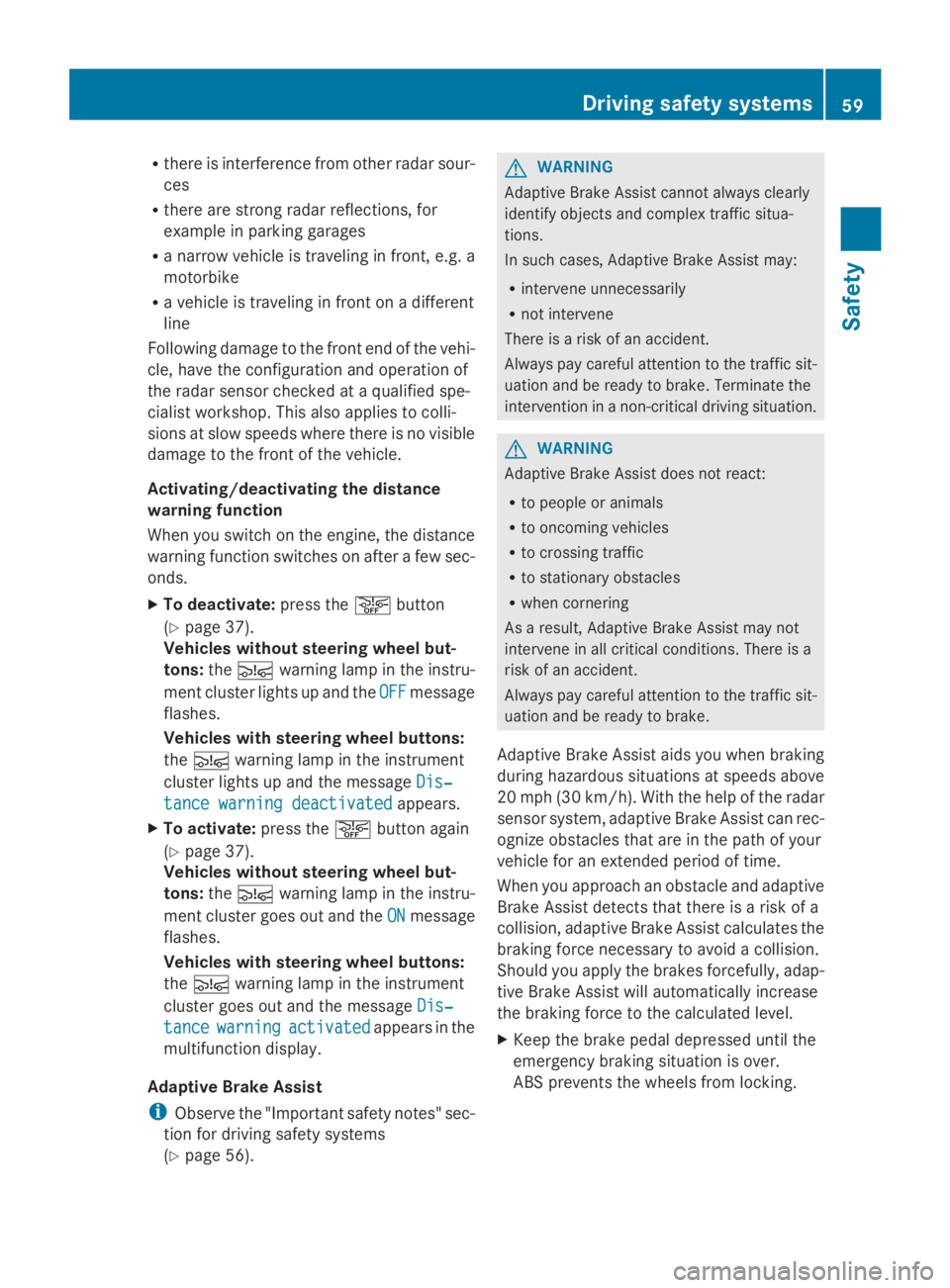
R
there is interference from other radar sour-
ces
R there are strong radar reflections, for
example in parking garages
R a narrow vehicle is traveling in front, e.g. a
motorbike
R a vehicle is traveling in front on a different
line
Following damage to the front end of the vehi-
cle, have the configuration and operation of
the radar sensor checked at a qualified spe-
cialist workshop. This also applies to colli-
sions at slow speeds where there is no visible
damage to the front of the vehicle.
Activating/deactivating the distance
warning function
When you switch on the engine, the distance
warning function switches on after a few sec-
onds.
X To deactivate: press the00D4button
(Y page 37).
Vehicles without steering wheel but-
tons: the00C7 warning lamp in the instru-
ment cluster lights up and the OFF
OFF message
flashes.
Vehicles with steering wheel buttons:
the 00C7 warning lamp in the instrument
cluster lights up and the message Dis‐ Dis‐
tance warning deactivated
tance warning deactivated appears.
X To activate: press the00D4button again
(Y page 37).
Vehicles without steering wheel but-
tons: the00C7 warning lamp in the instru-
ment cluster goes out and the ON
ON message
flashes.
Vehicles with steering wheel buttons:
the 00C7 warning lamp in the instrument
cluster goes out and the message Dis‐ Dis‐
tance
tance warning
warning activated
activated appears in the
multifunction display.
Adaptive Brake Assist
i Observe the "Important safety notes" sec-
tion for driving safety systems
(Y page 56). G
WARNING
Adaptive Brake Assist cannot always clearly
identify objects and complex traffic situa-
tions.
In such cases, Adaptive Brake Assist may:
R intervene unnecessarily
R not intervene
There is a risk of an accident.
Always pay careful attention to the traffic sit-
uation and be ready to brake. Terminate the
intervention in a non-critical driving situation. G
WARNING
Adaptive Brake Assist does not react:
R to people or animals
R to oncoming vehicles
R to crossing traffic
R to stationary obstacles
R when cornering
As a result, Adaptive Brake Assist may not
intervene in all critical conditions. There is a
risk of an accident.
Always pay careful attention to the traffic sit-
uation and be ready to brake.
Adaptive Brake Assist aids you when braking
during hazardous situations at speeds above
20 mph (30 km/h). With the help of the radar
sensor system, adaptive Brake Assist can rec-
ognize obstacles that are in the path of your
vehicle for an extended period of time.
When you approach an obstacle and adaptive
Brake Assist detects that there is a risk of a
collision, adaptive Brake Assist calculates the
braking force necessary to avoid a collision.
Should you apply the brakes forcefully, adap-
tive Brake Assist will automatically increase
the braking force to the calculated level.
X Keep the brake pedal depressed until the
emergency braking situation is over.
ABS prevents the wheels from locking. Driving safety systems
59Safety Z
Page 62 of 338
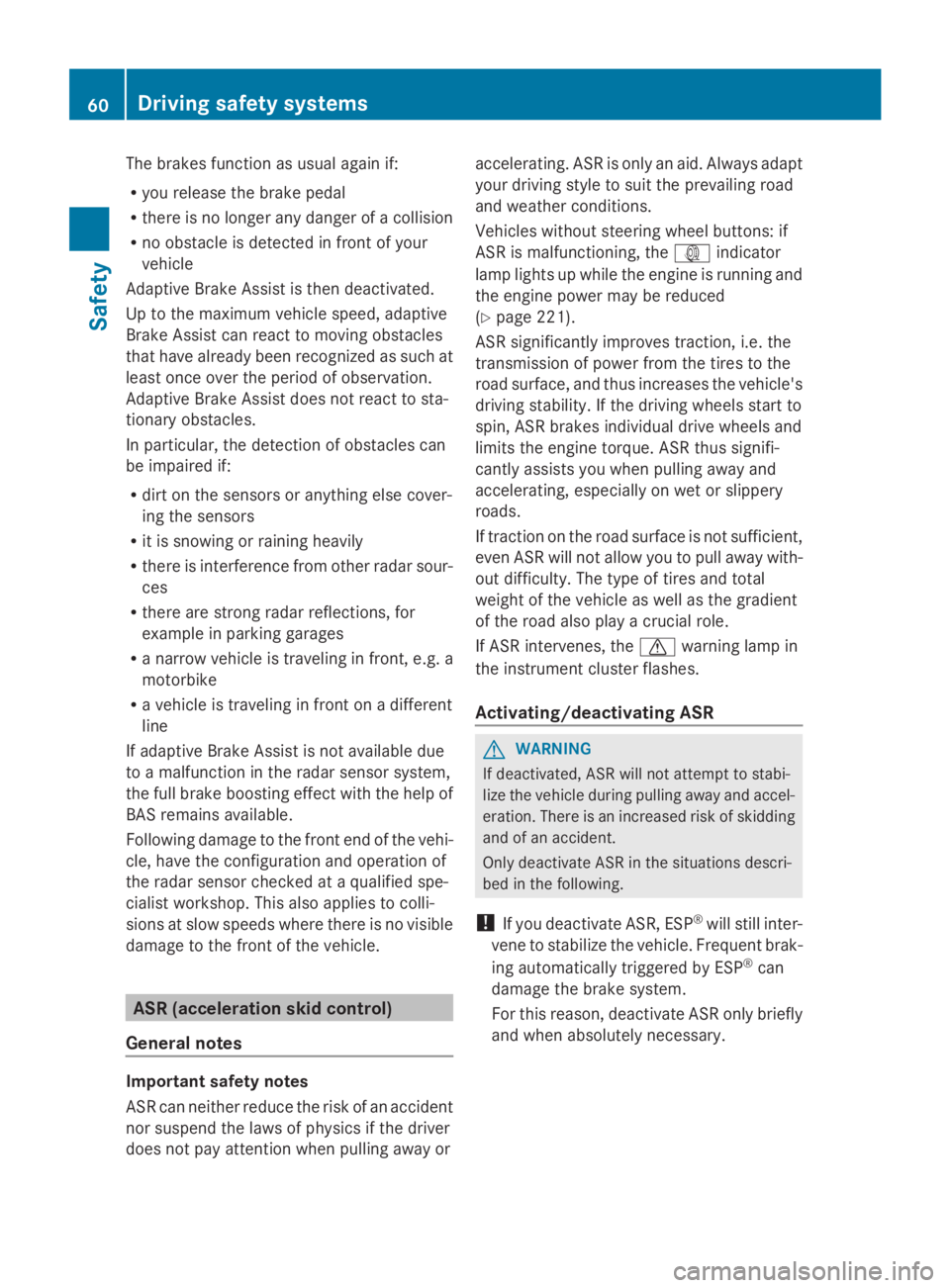
The brakes function as usual again if:
R you release the brake pedal
R there is no longer any danger of a collision
R no obstacle is detected in front of your
vehicle
Adaptive Brake Assist is then deactivated.
Up to the maximum vehicle speed, adaptive
Brake Assist can react to moving obstacles
that have already been recognized as such at
least once over the period of observation.
Adaptive Brake Assist does not react to sta-
tionary obstacles.
In particular, the detection of obstacles can
be impaired if:
R dirt on the sensors or anything else cover-
ing the sensors
R it is snowing or raining heavily
R there is interference from other radar sour-
ces
R there are strong radar reflections, for
example in parking garages
R a narrow vehicle is traveling in front, e.g. a
motorbike
R a vehicle is traveling in front on a different
line
If adaptive Brake Assist is not available due
to a malfunction in the radar sensor system,
the full brake boosting effect with the help of
BAS remains available.
Following damage to the front end of the vehi-
cle, have the configuration and operation of
the radar sensor checked at a qualified spe-
cialist workshop. This also applies to colli-
sions at slow speeds where there is no visible
damage to the front of the vehicle. ASR (acceleration skid control)
General notes Important safety notes
ASR can neither reduce the risk of an accident
nor suspend the laws of physics if the driver
does not pay attention when pulling away or accelerating. ASR is only an aid. Always adapt
your driving style to suit the prevailing road
and weather conditions.
Vehicles without steering wheel buttons: if
ASR is malfunctioning, the
003Dindicator
lamp lights up while the engine is running and
the engine power may be reduced
(Y page 221).
ASR significantly improves traction, i.e. the
transmission of power from the tires to the
road surface, and thus increases the vehicle's
driving stability. If the driving wheels start to
spin, ASR brakes individual drive wheels and
limits the engine torque. ASR thus signifi-
cantly assists you when pulling away and
accelerating, especially on wet or slippery
roads.
If traction on the road surface is not sufficient,
even ASR will not allow you to pull away with-
out difficulty. The type of tires and total
weight of the vehicle as well as the gradient
of the road also play a crucial role.
If ASR intervenes, the 0072warning lamp in
the instrument cluster flashes.
Activating/deactivating ASR G
WARNING
If deactivated, ASR will not attempt to stabi-
lize the vehicle during pulling away and accel-
eration. There is an increased risk of skidding
and of an accident.
Only deactivate ASR in the situations descri-
bed in the following.
! If you deactivate ASR, ESP ®
will still inter-
vene to stabilize the vehicle. Frequent brak-
ing automatically triggered by ESP ®
can
damage the brake system.
For this reason, deactivate ASR only briefly
and when absolutely necessary. 60
Driving safety systemsSafety
Page 143 of 338
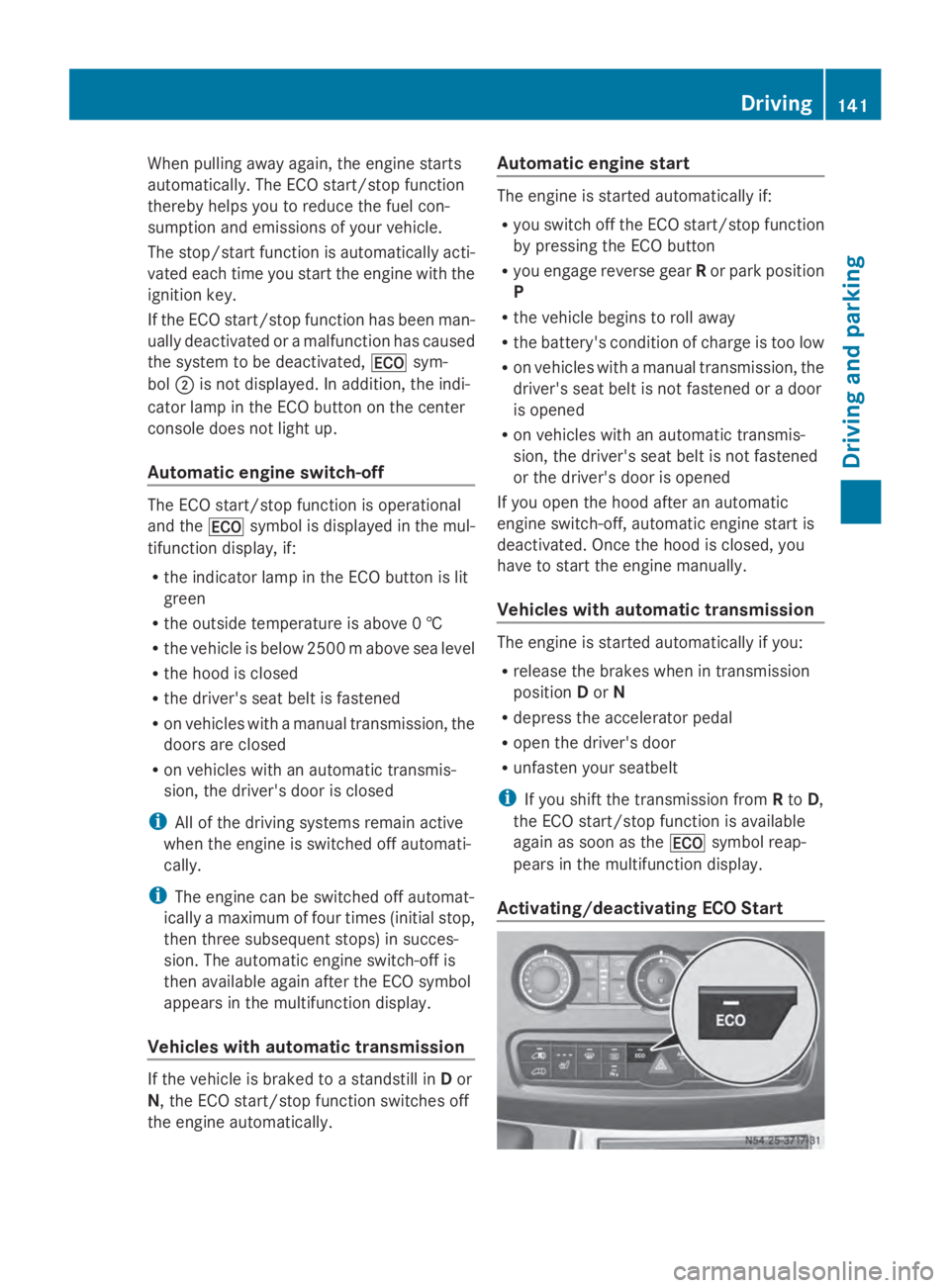
When pulling away again, the engine starts
automatically. The ECO start/stop function
thereby helps you to reduce the fuel con-
sumption and emissions of your vehicle.
The stop/start function is automatically acti-
vated each time you start the engine with the
ignition key.
If the ECO start/stop function has been man-
ually deactivated or a malfunction has caused
the system to be deactivated, 00A7sym-
bol 0044is not displayed. In addition, the indi-
cator lamp in the ECO button on the center
console does not light up.
Automatic engine switch-off The ECO start/stop function is operational
and the 00A7symbol is displayed in the mul-
tifunction display, if:
R the indicator lamp in the ECO button is lit
green
R the outside temperature is above 0 †
R the vehicle is below 2500 m above sea level
R the hood is closed
R the driver's seat belt is fastened
R on vehicles with a manual transmission, the
doors are closed
R on vehicles with an automatic transmis-
sion, the driver's door is closed
i All of the driving systems remain active
when the engine is switched off automati-
cally.
i The engine can be switched off automat-
ically a maximum of four times (initial stop,
then three subsequent stops) in succes-
sion. The automatic engine switch-off is
then available again after the ECO symbol
appears in the multifunction display.
Vehicles with automatic transmission If the vehicle is braked to a standstill in
Dor
N, the ECO start/stop function switches off
the engine automatically. Automatic engine start The engine is started automatically if:
R
you switch off the ECO start/stop function
by pressing the ECO button
R you engage reverse gear Ror park position
P
R the vehicle begins to roll away
R the battery's condition of charge is too low
R on vehicles with a manual transmission, the
driver's seat belt is not fastened or a door
is opened
R on vehicles with an automatic transmis-
sion, the driver's seat belt is not fastened
or the driver's door is opened
If you open the hood after an automatic
engine switch-off, automatic engine start is
deactivated. Once the hood is closed, you
have to start the engine manually.
Vehicles with automatic transmission The engine is started automatically if you:
R
release the brakes when in transmission
position Dor N
R depress the accelerator pedal
R open the driver's door
R unfasten your seatbelt
i If you shift the transmission from Rto D,
the ECO start/stop function is available
again as soon as the 00A7symbol reap-
pears in the multifunction display.
Activating/deactivating ECO Start Driving
141Driving and parking Z
Page 147 of 338
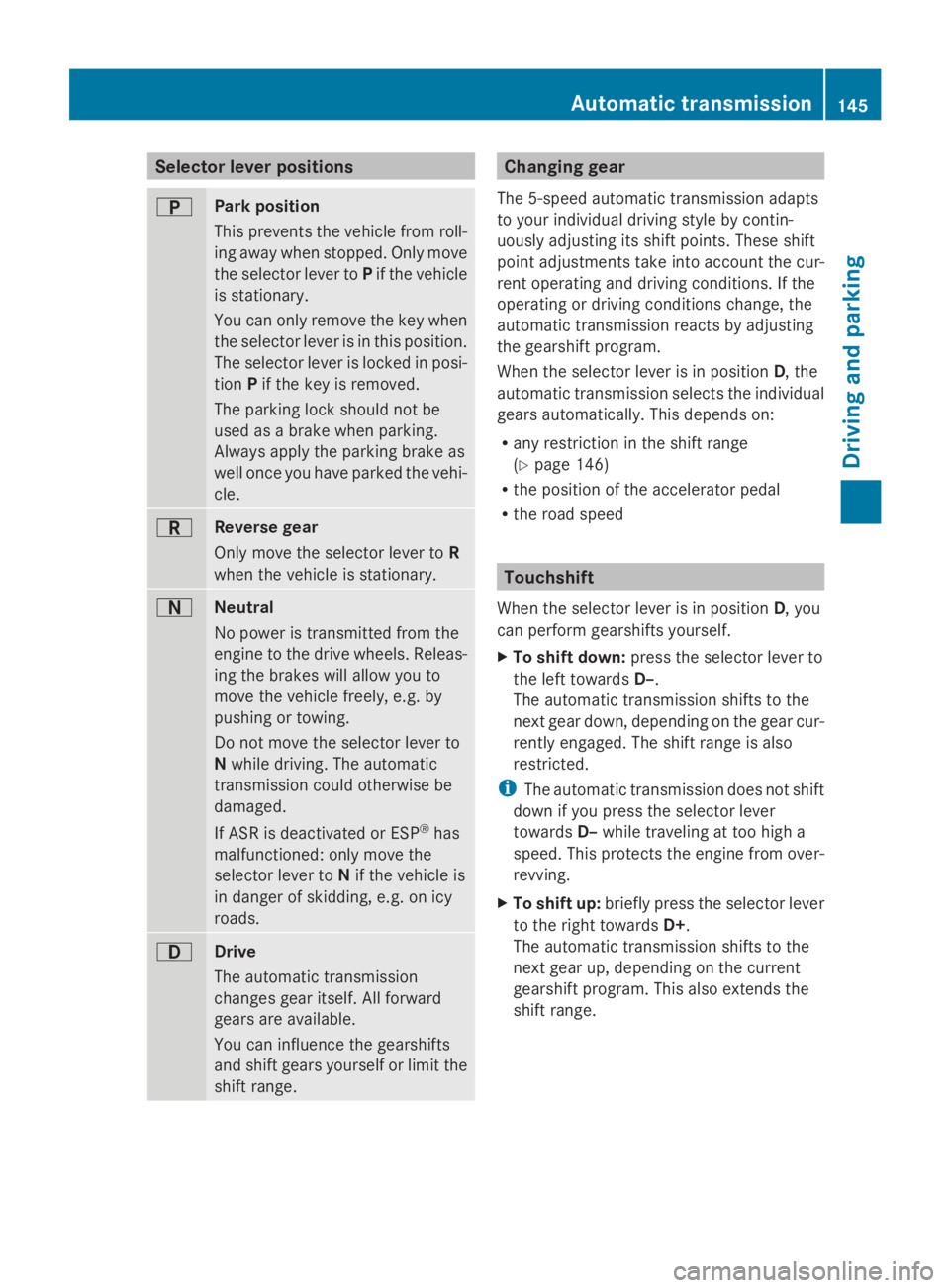
Selector lever positions
0045
Park position
This prevents the vehicle from roll-
ing away when stopped. Only move
the selector lever to
Pif the vehicle
is stationary.
You can only remove the key when
the selector lever is in this position.
The selector lever is locked in posi-
tion Pif the key is removed.
The parking lock should not be
used as a brake when parking.
Always apply the parking brake as
well once you have parked the vehi-
cle. 0046
Reverse gear
Only move the selector lever to
R
when the vehicle is stationary. 0044
Neutral
No power is transmitted from the
engine to the drive wheels. Releas-
ing the brakes will allow you to
move the vehicle freely, e.g. by
pushing or towing.
Do not move the selector lever to
N
while driving. The automatic
transmission could otherwise be
damaged.
If ASR is deactivated or ESP ®
has
malfunctioned: only move the
selector lever to Nif the vehicle is
in danger of skidding, e.g. on icy
roads. 003A
Drive
The automatic transmission
changes gear itself. All forward
gears are available.
You can influence the gearshifts
and shift gears yourself or limit the
shift range. Changing gear
The 5-speed automatic transmission adapts
to your individual driving style by contin-
uously adjusting its shift points. These shift
point adjustments take into account the cur-
rent operating and driving conditions. If the
operating or driving conditions change, the
automatic transmission reacts by adjusting
the gearshift program.
When the selector lever is in position D, the
automatic transmission selects the individual
gears automatically. This depends on:
R any restriction in the shift range
(Y page 146)
R the position of the accelerator pedal
R the road speed Touchshift
When the selector lever is in position D, you
can perform gearshifts yourself.
X To shift down: press the selector lever to
the left towards D–.
The automatic transmission shifts to the
next gear down, depending on the gear cur-
rently engaged. The shift range is also
restricted.
i The automatic transmission does not shift
down if you press the selector lever
towards D–while traveling at too high a
speed. This protects the engine from over-
revving.
X To shift up: briefly press the selector lever
to the right towards D+.
The automatic transmission shifts to the
next gear up, depending on the current
gearshift program. This also extends the
shift range. Automatic transmission
145Driving and parking Z
Page 148 of 338
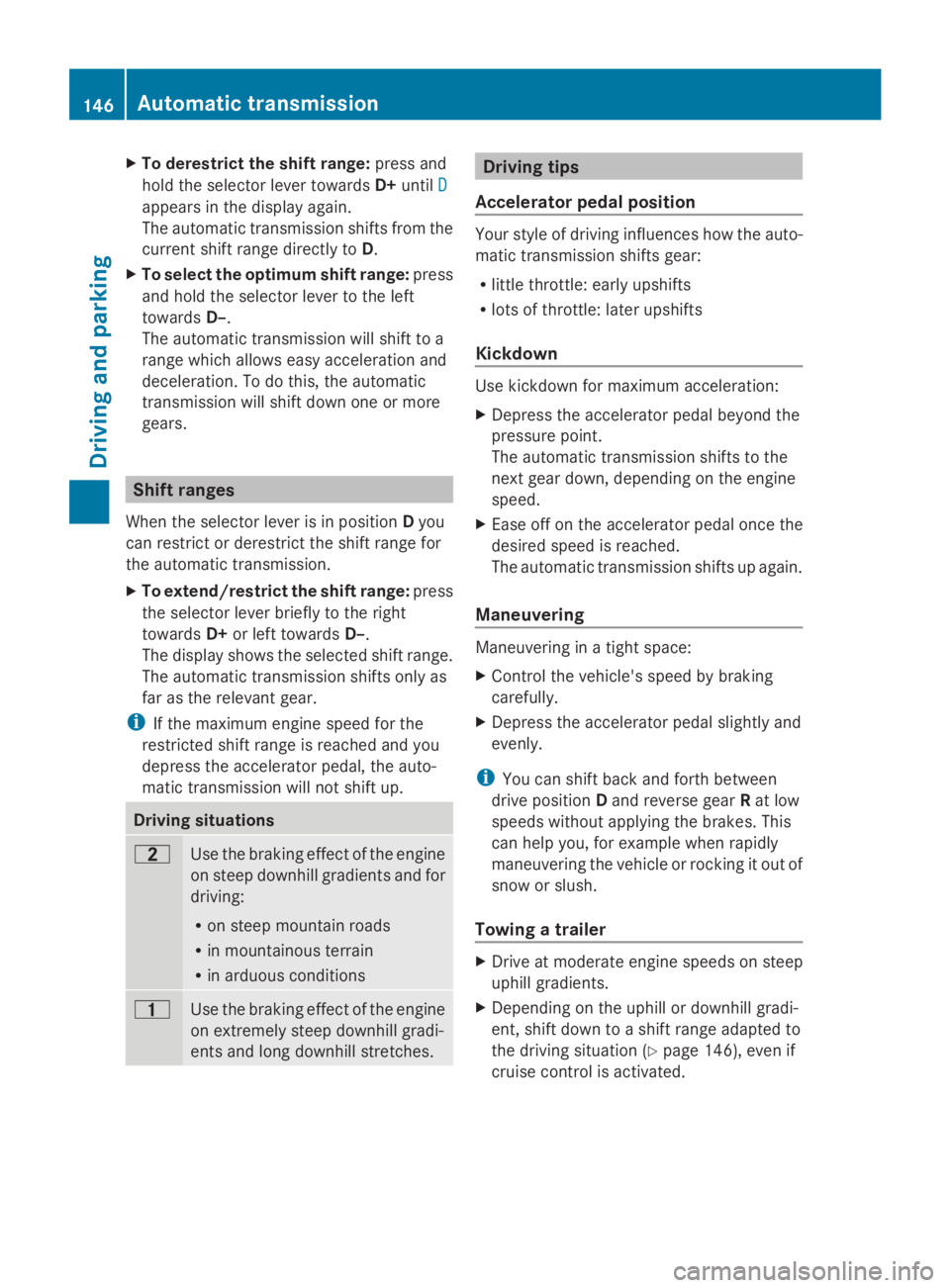
X
To derestrict the shift range: press and
hold the selector lever towards D+until D
D
appears in the display again.
The automatic transmission shifts from the
current shift range directly to D.
X To select the optimum shift range: press
and hold the selector lever to the left
towards D–.
The automatic transmission will shift to a
range which allows easy acceleration and
deceleration. To do this, the automatic
transmission will shift down one or more
gears. Shift ranges
When the selector lever is in position Dyou
can restrict or derestrict the shift range for
the automatic transmission.
X To extend/restrict the shift range: press
the selector lever briefly to the right
towards D+or left towards D–.
The display shows the selected shift range.
The automatic transmission shifts only as
far as the relevant gear.
i If the maximum engine speed for the
restricted shift range is reached and you
depress the accelerator pedal, the auto-
matic transmission will not shift up. Driving situations
0038
Use the braking effect of the engine
on steep downhill gradients and for
driving:
R
on steep mountain roads
R in mountainous terrain
R in arduous conditions 0037
Use the braking effect of the engine
on extremely steep downhill gradi-
ents and long downhill stretches. Driving tips
Accelerator pedal position Your style of driving influences how the auto-
matic transmission shifts gear:
R little throttle: early upshifts
R lots of throttle: later upshifts
Kickdown Use kickdown for maximum acceleration:
X
Depress the accelerator pedal beyond the
pressure point.
The automatic transmission shifts to the
next gear down, depending on the engine
speed.
X Ease off on the accelerator pedal once the
desired speed is reached.
The automatic transmission shifts up again.
Maneuvering Maneuvering in a tight space:
X
Control the vehicle's speed by braking
carefully.
X Depress the accelerator pedal slightly and
evenly.
i You can shift back and forth between
drive position Dand reverse gear Rat low
speeds without applying the brakes. This
can help you, for example when rapidly
maneuvering the vehicle or rocking it out of
snow or slush.
Towing a trailer X
Drive at moderate engine speeds on steep
uphill gradients.
X Depending on the uphill or downhill gradi-
ent, shift down to a shift range adapted to
the driving situation (Y page 146), even if
cruise control is activated. 146
Automatic transmissionDriving an
d parking